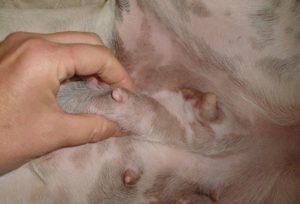Whether female, male, human, animal adult or child, every mammal has breast tissue and all tissue runs the risk of developing cancer.
Most of us know a friend or family member that has come down with breast cancer. Hard as it is to believe, so can companion animals, October is Breast Cancer awareness month. In preparation for this as well as to help your companion cat or dog, here’s some information:
Some numbers may help to illustrate the risks to dogs and cats. For humans, breast cancer happens more frequently in more developed countries, and accounts for about 10 percent of all deaths in women between 20 and 59 (source: World Health Organization).
Data for dogs and cats and other domestic species are harder to come by as there is no World Doggy Health Organization database to be accessed as easily as WHO data, but estimates are that 1 in 4 dogs who are not spayed and experience more than two or more heat cycles will develop mammary tumors. Not spaying your pet is a high risk gamble..
When a system is developed, the risk of mammary cancer is virtually unheard of to quite low. Learn more about the specifics of the disease and treatment in dogs and cats
The terminology surrounding lumps, tumors and cancer can be a little daunting sometimes, and is often a source of confusion. One thing to keep in mind is that the word tumor does not always mean cancer. Cancer implies malignancy, or a predilection to grow rapidly and spread to other parts of the body: it’s a process known as metastasis, in which a tumor says, in essence, I’m outta here and decides to infiltrate new and exciting regions for growth. A tumor can be benign or malignant, but cancer is always malignant.
Medicine is often like that – the invasive stuff is the most accurate, and the easiest stuff gives you the least useable information. It’s like food where the good stuff tastes bad and the stuff that tastes great kills you. The universe can seem like a vast, cruel joke some days.So how do we know which lump is bad, and which is not likely to be a problem for our pets? Sadly, there’s no easy way.
Any lump found on a pet’s mammary gland has the potential to be cancerous, so having your veterinarian remove the lump (or a piece of it, in what is known as an incisional biopsy) and submit it for analysis is an important part of keeping your pets safe from this disease. A biopsy is a piece of tissue that can be preserved and looked at under a microscope by a pathologist to determine what the lump is (mammary tissue vs. some other tissue that just decided on a whim to form a lump) and whether the lump is cancerous, or as doctors call it, malignant. You can’t tell if tissue is cancerous just by the way it looks, how it feels or where it is.
 There is one intermediate step that can offer information to your veterinarian on how extensive or radical surgery to remove the lump should be. This is known as a fine needle aspirate, or FNA. With an FNA, you don’t get a piece of the mass, you just suck some cells up into the needle and place them onto a slide. It is much less invasive and doesn’t usually require any sedation or anesthesia, but the trade-off is that it is a less accurate test and less likely than a surgical biopsy to tell you the badness level of the tumor. An FNA is actually notoriously unreliable for mammary masses as far as predicting malignancy but can help make sure the lump is from mammary tissue and not something else that set up shop in the same area.
There is one intermediate step that can offer information to your veterinarian on how extensive or radical surgery to remove the lump should be. This is known as a fine needle aspirate, or FNA. With an FNA, you don’t get a piece of the mass, you just suck some cells up into the needle and place them onto a slide. It is much less invasive and doesn’t usually require any sedation or anesthesia, but the trade-off is that it is a less accurate test and less likely than a surgical biopsy to tell you the badness level of the tumor. An FNA is actually notoriously unreliable for mammary masses as far as predicting malignancy but can help make sure the lump is from mammary tissue and not something else that set up shop in the same area.
I know this sounds complex, intimidating and potentially invasive – not to mention expensive. The good news is that the take-home on this is pretty simple: spay your pet before she goes into heat, unless you have a rock-solid breeding plan for your purebred pet, and have your veterinarian check out any suspicious lumps. That’s about it. Luckily, your trusted family veterinarian has the skills and knowledge to guide you and your pet through this maze to ensure the highest degree of success.
Houston Heights hospital for cats
Urban Animal Veterinary Hospital
1327 Yale St
Houston, TX 77008
(713) 863-0088


